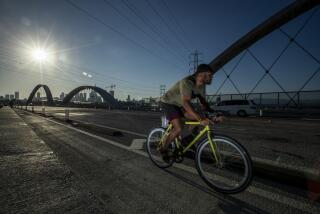Op-Ed: People of color are dying from traffic violence at a much higher rate. Here’s why

- Share via
On a rainy Thanksgiving night in 2019, Jihad Muhammad, 62, was standing by a crosswalk on Adams Boulevard near West View Street when he was struck by a white Audi whose driver sped off, leaving him lying on the street.
Then Muhammad was struck a second time. The second driver fled as well.
Finally, a third driver struck Muhammad, dragging his body nearly a mile before pulling over at a gas station at Adams and Crenshaw. That driver also left the scene.
Muhammad’s death offers an ugly snapshot of how cruel the streets of Los Angeles can be.
Too often, our tendency in pedestrian crashes is to write them off as the result of individual bad decision making. In an egregious case like this one, maybe it is chalked up to a few bad actors. In other cases, we blame pedestrians for “not being in the crosswalk,” or “not wearing bright clothing” or some other rationalization that amounts to “wrong place, wrong time.”
But Muhammad’s death is part of a larger pattern — an epidemic of rising pedestrian deaths and traffic violence that is endangering us all but is having a disproportionate effect on people of color in low-income neighborhoods.
Pedestrian deaths around the country have increased steadily and sharply. Now about 6,400 people are killed annually — about a 50% increase over 10 years earlier. Roughly the same pattern is apparent in Los Angeles. Pedestrian deaths are up 36% in the city since Vision Zero (an initiative aimed at gradually eliminating traffic fatalities) became policy in 2015.
There are many reasons for this dramatic nationwide increase. One is that the American population is aging. Almost a quarter of Americans are 65 or older. Older people are a little slower, a little frailer — and have always been more likely to be killed while walking. But now more of us fall into that category.
In addition, more Americans are living in Sun Belt cities. These are, almost without exception, the most dangerous to walkers — having developed since the rise of the auto era.
And the vehicle mix has shifted over the last decade. Increasingly, Americans are opting for higher-riding SUVs. In 2015, the National Highway Traffic Safety Administration reported that pedestrians struck by SUVs are 2½ times more likely to be killed than those struck by sedans.
Although those factors help explain the growth in pedestrian deaths, they don’t explain why the fallout is so unequally distributed.
Madeline Brozen and Annaleigh Yahata Ekman at UCLA’s Lewis Center for Regional Policy Studies wrote in a policy brief last year that Black residents in Los Angeles represent 18% of all collision victims — even though they account for only about 8% of the city’s population. The data collection is imperfect because of the varied ways the incidents are reported, but those whose race was classified as “other,” including Indigenous Angelenos, are killed at disproportionate rates as well. Latino people represent the largest share of walking and biking deaths in the city overall (although the number is proportional to their share of the population).
Nationwide, immigrants, low-income people and people of color account for an outsize share of pedestrian deaths. People in low-income neighborhoods where the median per capita income is less than $21,000 are killed while walking at twice the rate of those living in neighborhoods where the per capita income is more than $31,000.
This is partly because lower-income people and people of color are less likely to have cars and therefore walk more, but it’s also because of infrastructure inequality, civic neglect, gentrification and the suburbanization of poverty. Lower income neighborhoods often don’t have traffic lights or sidewalks or have too few marked crosswalks. Lack of affordable housing also contributes. When Jihad Muhammad was killed, he was experiencing homelessness, which is a major risk factor for a death while walking.
In L.A., as in most cities, a small number of streets accounts for an overwhelming share of traffic fatalities. The city’s “high injury network” is 450 streets, according to the Department of Transportation — or 6% of the total. These streets, which account for 70% of serious injuries and fatalities, are concentrated in Black and Latino neighborhoods.
Between 2009 and 2019, for instance, 59 severe and fatal collisions occurred on Adams Boulevard between Crenshaw and Fairfax, according to the Adams Boulevard Safety Project of the L.A. Department of Transportation. These collisions caused 10 deaths (including six pedestrians) and 59 severe injuries.
Starting in 1961, construction of the 10-lane 10 Freeway tore through West Adams’ core, with the freeway running just north of Adams Boulevard. Now the main corridors surrounding it, including parts of Adams, La Cienega, Jefferson and Crenshaw boulevards, are sites of extreme congestion during peak commuting hours. Drivers are also resorting to aggressively using the residential streets to reach their destinations.
Brozen and Ekman concluded that Vision Zero’s road safety funds need to be prioritized for neighborhoods that have the greatest needs and disparities. That’s mostly Black neighborhoods such as West Adams, Baldwin Hills and Hyde Park, and more heavily Latino neighborhoods such as Florence or Watts.
In a troubling national trend that has perplexed advocates and experts, pedestrian deaths are increasing, disproportionately affecting lower-income, minority communities.
Fortunately, LADOT is planning a series of improvements along the Adams Boulevard corridor. But protecting the most vulnerable will mean putting neighborhood safety ahead of convenience, including that of higher-income commuters eager to get quickly from home to work and back. It also will require agencies and politicians to include BIPOC community residents in these efforts based on on-the-ground truths around equity, safety and mobility justice, as defined by the community.
Angie Schmitt is the author of “Right of Way: Race, Class and the Silent Epidemic of Pedestrian Deaths in America.” Yolanda Davis-Overstreet is the acting interim board chair of People for Mobility Justice and vice president of the West Adams Neighborhood Council.
More to Read
A cure for the common opinion
Get thought-provoking perspectives with our weekly newsletter.
You may occasionally receive promotional content from the Los Angeles Times.










